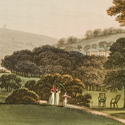A Bibliophile Librarian Collects, 1806-1829
Preston’s bequest introduced Philadelphians to a whole new style of book collecting. Under the leadership of newly appointed Librarian George Campbell, the Library Company began to buy color-plate books again.
As the membership grew richer, they still expected their library to buy useful books they could not afford privately, but now the threshold of affordability was higher, and utility was redefined in terms of refinement of taste.
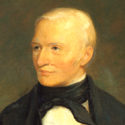 Thomas Sully. George Campbell. Oil on canvas, 1858. Gift of Edwin Wolf, 2nd, 1960.
Thomas Sully. George Campbell. Oil on canvas, 1858. Gift of Edwin Wolf, 2nd, 1960.
George Campbell, Jr., appointed Librarian in 1806, was a cultivated bibliophile who was well-suited to the job of caring for the Preston bequest and adding more such books to the collection. He was the librarian who signed up for three copies of Wilson’s Ornithology; and he soon began to import color-plate books from London quite regularly, as many as half a dozen a year. Most of them were in a new genre, travel books heavily illustrated with views delicately rendered in aquatint and finished by hand with watercolor.
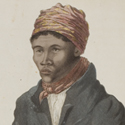 William J. Burchell. Travels in the Interior of Southern Africa, London: Longmans, 1822. Purchased 1822.
William J. Burchell. Travels in the Interior of Southern Africa, London: Longmans, 1822. Purchased 1822.
This was the most authoritative book of its time about South Africa. Its author Burchell engraved and colored all the illustrations, including a striking portrait of his Hottentot guide Júli; and he was one of the first to make panoramic views with the aid of scenographic projection on a revolving cylinder. He brought back thousands of specimens that are still in the Victoria and Albert Museum.
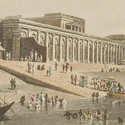 Thomas and William Daniell. A Picturesque Voyage to India; by way of China. London: Longmans, 1810. Purchased 1820.
Thomas and William Daniell. A Picturesque Voyage to India; by way of China. London: Longmans, 1810. Purchased 1820.
The Daniell views of India and China represented a high point in the fashion for aquatinted travel books. They were praised equally for their beauty and their accuracy. Given that trade with India and China was a source of new wealth for many Library Company shareholders, this was an appropriate acquisition, but it heralded a new conception of what was a useful book.
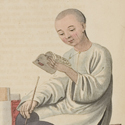 George Henry Mason. The Costume of China, bound with The Punishments of China. London: W. Miller, 1800-1801. Purchased 1825.
George Henry Mason. The Costume of China, bound with The Punishments of China. London: W. Miller, 1800-1801. Purchased 1825.
The subject of this book is people, not landscape or architecture. The first part depicts diverse occupations and trades of China; and the second documents the sickeningly cruel tortures inflicted on even petty criminals. The book was conceived in categories of civilization and barbarism, reflecting the ambivalence of Westerners towards an ancient culture they were both emulating and exploiting as never before.
Humphry Repton. Observations on the Theory and Practice of Landscape Gardening. London: T. Bensley, 1803. Purchased 1804.
Repton’s book, with its “before and after” flaps, was bought the year after it was published. His ideas about bringing out the latent natural characteristics in the landscape launched a new gardening style. This was the sort of useful book the newly rich shareholders needed to keep up with English fashions. Its influence was extended when Philadelphian Bernard M’Mahon, America’s first real landscape gardener, copied Repton’s ideas in his 1806 American Gardener’s Calendar.
ooooooo

